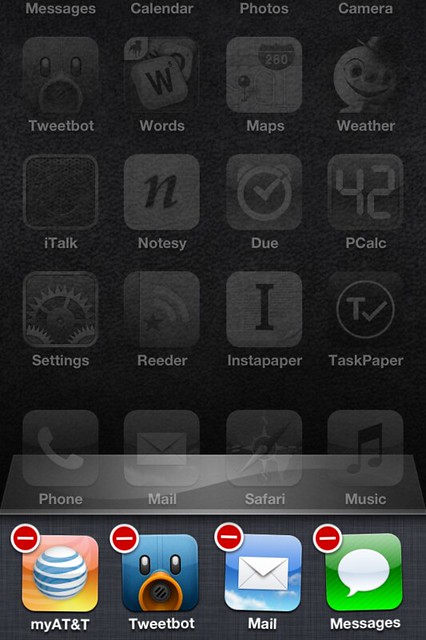Killing iOS apps
January 8, 2012 at 8:35 AM by Dr. Drang
Now that all the successful and punctual bloggers have had their say about Fraser Speirs’s nicely written “Misconceptions About iOS Multitasking” post, it’s time for me to weigh in. Being timely has never been my strong suit.
The gist of Fraser’s post is that people—including people who should know better, like Apple Geniuses—seem to think that the apps in the multitasking bar are actually running, eating up RAM and processor time and slowing down your iPhone or iPad. This has led to a growing group of people who obsessively prune their multitasking bar of apps they aren’t currently using. As Fraser points out, this is both a waste of time (usually) and counter to Apple’s careful design of iOS’s multitasking system, which deactivates all but a very few apps as soon as you switch out of them and culls them from memory whenever that memory is needed by another app.
There are, as everyone has pointed out, exceptions to the “you don’t have to kill iOS apps” rule. Sometimes those few apps that are allowed to continue processing in the background go haywire and need to be killed by hand. GPS apps seem to be the common culprits.
I’ve run into a few situations where killing apps by hand has helped, and it had nothing to do with GPS. The apps in question are Tweetbot and Reeder, two apps that are highly thought of and seem to be well written. The problem arises when I’m in an area with dodgy 3G coverage
According to Fraser and the others, background tasks are allowed only 10 minutes to keep a network connection going before iOS puts a stop to it. I have no reason to doubt that both Tweetbot and Reeder are stopped when this limit is reached—I’ve never noticed my battery’s charge level dropping in these situations—but I have noticed that when they have a 3G connection failure, they sometimes still can’t connect even after I’ve moved to an area with a better signal. They get stuck in the middle of an update and just spin their wheels.
When this happens, killing them and relaunching has fixed the problem. They update almost immediately after the relaunch. Because it happens with both apps—I can’t remember a single time in which one of the apps has been able to update and the other hasn’t—I suspect the problem lies with iOS, not the apps themselves. And I should mention that while this was a problem that arose fairly frequently (once a month, maybe) under iOS 4, it hasn’t come up yet under iOS 5.
There’s another bit of iOS voodoo floating around that I’d like to see Fraser tackle: recalibrating your home button. My gut feeling is that this, too, is a waste of time.
Update 1/9/12
The best way to get a question like this answered is to be lucky enough to have one the big boys link to you.
Last night, Marco Arment wrote a post focusing on my last paragraph, and he also tweeted about it. The consensus is that the “recalibration” procedure is, indeed, voodoo. According to folks who’ve looked at their iPhones’ error logs, the procedure simply force-quits the active app.
-
Which seems to include most major US airports. A more conspiracy-minded person would think this is due to a shadowy collusion between the airports, AT&T, and Boingo to get me to pop for an absurdly expensive hour of WiFi while I’m held captive at a gate. ↩

